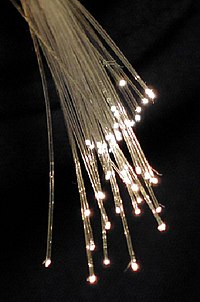
Photo from wikipedia
such an historical assessment provides a valid measure of the vitality of current research? Those doubts can be weighed against the certainty of examples where research has indeed lead to… Click to show full abstract
such an historical assessment provides a valid measure of the vitality of current research? Those doubts can be weighed against the certainty of examples where research has indeed lead to major developments having societal benefit. The present book offers two facets of the beneficial effects of research and development. As it is well-known, that the optical fibre was developed to meet a specific requirement in using light in telecommunications. It should not be forgotten, however, that alternative optical communication channels were being vigorously developed before the work of Charles Kao confirmed the feasibility of low-loss glass fibres. Although the driver for this development was well-defined, the impact of the development of optical fibres has been considerably wider with their use as sensors being a particularly significant spin-off from the primary aim of developing a reliable light-based communication technology. It is interesting to learn in a preface to this book by Brian Culshaw– himself a major player in fibre-optic sensors – that potential users of fibre sensors did not immediately recognise the significance of the development. This underlines the need to invest in such research even when the means for gaining return on that investment are not immediately obvious. On the other hand, the author of this book has personally exemplified how research may be impactful. Having begun his research career in the world-famous Optical Fibre Research Group led by Alec Gambling at Southampton University, the author moved to York Ltd a start-up company which was based on the research expertise of the Southampton Optical Fibre Group. One outcome of his PhD work was the demonstration in 1982 of a distributed optical fibre sensor. Whilst at York he led a team which designed and commercialised the first Raman distributed temperature sensor. This in turn led to the establishment of another company: York Sensors. It is the nature of many such technology companies that they undergo changes of ownership often accompanied by a change of name. York Sensors are now part of Schlumberger but, crucially, the technology emanating from Arthur Hartog’s research and development is still being used and enhanced. Based on the foregoing it should be apparent that the present book is written by an authority in the field. The author has deployed his vast experience and great expertise to produce a major volume treating all-aspects of distributed optical fibre sensors. The book contains basic physical principles as well as detailed discussion of the construction and applications of such fibre sensors. Mathematical treatment is counter poised by insights into industrial requirements. Excellent diagrams and figures and numerous references to the literature augment the core text. The book is organised into three main sections concerning respectively: Fundamentals; Distributed Sensing Technology and Applications of Distributed Sensors. To illustrate the breadth of vision offered here, one may list just some of the applications of strain sensors: energy cables; tele-communications; offshore structures; tunnels; pipeline integrity monitoring. Temperature and vibration sensors have similarly long and varied application contexts including borehole measurements, carbon dioxide sequestration, cement and concrete curing, pipeline security surveillance, wind and ice loading in of the structure of molecules. In theme with the principal aim of understanding extreme interactions, the author swiftly expands upon relativistic wave equations in Chapter 2 and in Chapter 3, reviews the necessary topics of electrodynamics needed for later chapters such as short pulses and modulated waves. Chapter 4 defines the dynamics of a charge interacting with an electromagnetic wave – in particular, the impact on an atom by a very short pulse is investigated and finally, the author describes the basic principles behind the field reaction force. Chapter 5 addresses the problem of confinement of charges and Chapter 6 develops firstand second-order interactions of an atom in an electromagnetic field. The final chapter develops radiation by charge under non-uniform motion. Considering that the aim of this book is to provide clear derivations and a continuous theoretical framework, this book is a success. However, some pedagogical steps are sacrificed in order to swiftly address these exceptional cases. In this regard, the reader is directed to references to supplement the compact explanations, leading me to avoid suggesting this book as a stand-alone textbook. Rather, considering the easily digestible derivations, this book may prove to be a useful companion to the researcher in this field as a complimentary guide and reference. I will certainly find a use for this book in approaching electromagnetic interactions and will keep it within easy reach on my bookshelf.
Journal Title: Contemporary Physics
Year Published: 2017
Link to full text (if available)
Share on Social Media: Sign Up to like & get
recommendations!